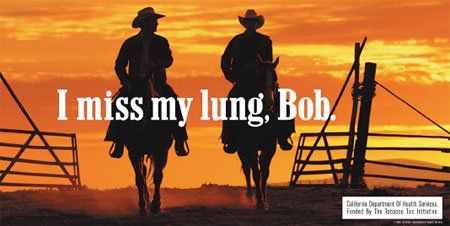California Campaign Slams Smoking; Lung Ca Rates Fall
Lung and bronchus cancer rates have declined in California at a faster rate than in the United States as a whole, mirroring a decline in tobacco consumption and helping to validate anti-tobacco efforts aimed primarily at changing societal norms regarding smoking.
WASHINGTONLung and bronchus cancer rates have declined in California at a faster rate than in the United States as a whole, mirroring a decline in tobacco consumption and helping to validate anti-tobacco efforts aimed primarily at changing societal norms regarding smoking. "We decided not to focus on individual behavior change," said Gregory Oliva, from the tobacco control section in California's Department of Health Services. "We did not operate a cessation program; we did not operate a youth program; we operated a program to try to change societal norms and the environment, where tobacco became less desirable, less acceptable, and less accessible," Mr. Oliva emphasized.
He summarized California's anti-tobacco program, and some of the outcome data now available, at the World Cancer Congress, convened by the International Union Against Cancer (abstract 44-2). [See also page 4 for a report of the recent Federal court ruling on the tobacco company "conspiracy."]
California's comprehensive anti-tobacco campaign got its start in 1988 when voters passed Proposition 99, authorizing a 25-cent increase in cigarette taxes, with 5 cents on each pack earmarked for tobacco control. With a budget now at $60 million, the department has focused on four strategies: smoking cessation services plus three policy-related strategies aimed at reducing exposure to second-hand smoke, decreasing tobacco sales to youth, and countering tobacco industry influence (see ad below). "We think we have a one-two punch in California," Mr. Oliva said. The first is making it harder to smoke, eg, banning smoking in public places and enforcing the ban on sales to minors. And the second is making it easier to quit, by providing a help line.

Underlying all its efforts, Mr. Oliva said, was the premise that it is not the smoker who is at fault, it is the industry. "We've always demonized the industry and not the smoker," he said.
An aggressive marketing and media campaign pointed fingers at the industry. At the same time, activists were working to establish no-smoking policies at the local level, in what Mr. Oliva described as "one of the bread and butter issues for our program." Once about 100 local jurisdictions had established anti-smoking policies, it was possible to go to the state levelwhere tobacco lobbies were also strongand start advocating for anti-smoking legislation.
Recent statistics suggest that this approach has worked. In 2005, 14% of adults in California smoked vs 26% in 1984. Pack consumption is down 60% to 44 packs per capita in 2005, half that in the rest of the country. And an increasing number of California smokers are just occasional or light smokers. In 1984, smokers had an average 15.2 cigarettes a day, while in 2005 that was down to 10.6. Youth smoking rates have also declined. In 2004, 13.2% of high school students smoked; nationally the rate was 22.3%.
The effect on cancer rates has also been dramatic. From 1998 to 2002, lung and bronchus cancer rates declined at nearly four times the national rate of decline. And six out of the nine cancers linked to tobacco had a lower incidence in California than in the rest of the country.
How can other jurisdictions do what California is doing? The resourcesthe earmarked tax proceedsare critical, Mr. Oliva said, as are people and political will on the local level. And he believes that the focus on changing norms is essential.
"While cessation is important, I would not plug a whole bunch of money into cessation," he said. "You're making change one person at a time, rather than actually implementing policy that's legislative, that's going to create lasting change, and that's going to change people's perceptions about tobacco use and ultimately the tobacco industry."
California hopes to expand its program, Mr. Oliva said. Another ballot initiative in November of this year will propose raising the tax on cigarettes by $2.60, from $0.87 to $3.47. Again, the proceeds would be earmarked for tobacco control and other health programs.
Projections are that the increased tax alone would result in 500,000 fewer smokers in the state, he said, bringing adult smoking down to 12.2% and reducing the number of packs smoked by 312 million.
Newsletter
Stay up to date on recent advances in the multidisciplinary approach to cancer.